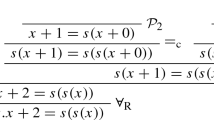Abstract
The model elimination theorem prover SETHEO (version V3.3) and its equational extension E-SETHEO are presented. SETHEO employs sophisticated mechanisms of subgoal selection, elaborate iterative deepening techniques, and local failure caching methods. Its equational counterpart E-SETHEO transforms formulae containing equality (using a variant of Brand's modification method) and processes the output with the standard SETHEO system. This article gives an overview of the theoretical background, the system architecture, and the performance of both systems.
Similar content being viewed by others
References
Astrachan, O. L. and Stickel, M. E.: Caching and lemmaizing in model elimination theorem provers, in CADE-11, LNAI 607, Springer, 1992, pp. 224–238.
Bachmair, L., Ganzinger, H., Lynch, C. and Snyder, W.: Basic paramodulation, Information and Computation 121(2) (1995), 172–192.
Bibel, W.: Automated Theorem Proving, Vieweg Verlag, Braunschweig, 1987.
Brand, D.: Proving theorems with the modification method, SIAM Journal of Computing 4(4) (1975), 412–430.
McCune, W. W. and Wos, L.: Otter: The CADE-13 competition incarnations, Journal of Automated Reasoning 18(2) (1997).
Gallier, J. and Snyder, W.: Complete sets of transformations for general E-unification, Theoretical Computer Science 67 (1989), 203–260.
Goller, C., Letz, R., Mayr, K. and Schumann, J.: SETHEO V3.2: Recent developments - system abstract, in CADE-12, LNAI 814, Springer, 1994, pp. 778–782.
Harrison, J.: Optimizing proof search in model elimination, CADE-13, LNAI 1104, Springer, 1996, pp. 313–327.
Ibens, O. and Letz, R.: Subgoal Alternation in Model Elimination, Technical Report, Institut für Informatik, Technische Universität München, 1996.
Knuth, D. E. and Bendix, P. B.: Simple word problems in universal algebras, inConference on Computational Problems in Abstract Algebra, Pergamon Press, 1970, pp. 263–297.
Letz, R., Mayr, K. and Goller, C.: Controlled integration of the cut rule into connection tableau calculi, Journal of Automated Reasoning 13 (1994), 297–337.
Letz, R., Schumann, J., Bayerl, S. and Bibel, W.: SETHEO: A high-performance theorem prover, Journal of Automated Reasoning 8 (1992), 183–212.
Loveland, D. W.: Automated Theorem Proving: A Logical Basis, North-Holland, New York, 1978.
Moser, M.: Improving transformation systems for general E-unification, in RTA-5, LNCS 690, Springer, 1993, pp. 92–105.
Moser, M.: Goal-Directed Reasoning in Clausal Logic with Equality, Dissertation, Institut für Informatik, TU München, 1996.
Moser, M.: Compiling Basic Paramodulation to Logic, Technical Report, Institut für Informatik, TU München, 1996. To appear.
Moser, M., Lynch, C. and Steinbach, J.:Model Elimination with Basic Ordered Paramodulation, Technical Report AR-95-11, Institut für Informatik, Technische Universität München, 1995.
Robinson, J. A.: A machine-oriented logic based on the resolution principle, Journal of the ACM 12(1) (1965), 23–41.
Robinson, G. A. and Wos, L.: Paramodulation and theorem proving in first-order theories with equality, Machine Intelligence 4 (1969), 135–150.
Schumann, J. and Ibens, O.: SETHEO V3.3 Reference Manual, Technical Report, Institut für Informatik, TU München, 1996. To appear.
Shostak, R. E.: Refutation graphs, Artificial Intelligence 7 (1976), 51–64.
Smullyan, R. M.: First Order Logic, Springer, 1968.
Stickel, M. E.: A Prolog technology theorem prover: Implementation by an extended Prolog compiler, Journal of Automated Reasoning 4 (1988), 353–380.
Sutcliffe, G. and Suttner, C. B.: The results of the CADE-13 ATP system competition, Journal of Automated Reasoning 18(2) (1997).
Sutcliffe, G., Suttner, C. B. and Yemenis, T.: The TPTP problem library, in A. Bundy (ed.), Proc. of the 12th International Conference on Automated Deduction, Lecture Notes in Artificial Intelligence 814, Springer-Verlag, 1994, pp. 252–266.
Author information
Authors and Affiliations
Rights and permissions
About this article
Cite this article
Moser, M., Ibens, O., Letz, R. et al. SETHEO and E-SETHEO - The CADE-13 Systems. Journal of Automated Reasoning 18, 237–246 (1997). https://doi.org/10.1023/A:1005808119103
Issue Date:
DOI: https://doi.org/10.1023/A:1005808119103




